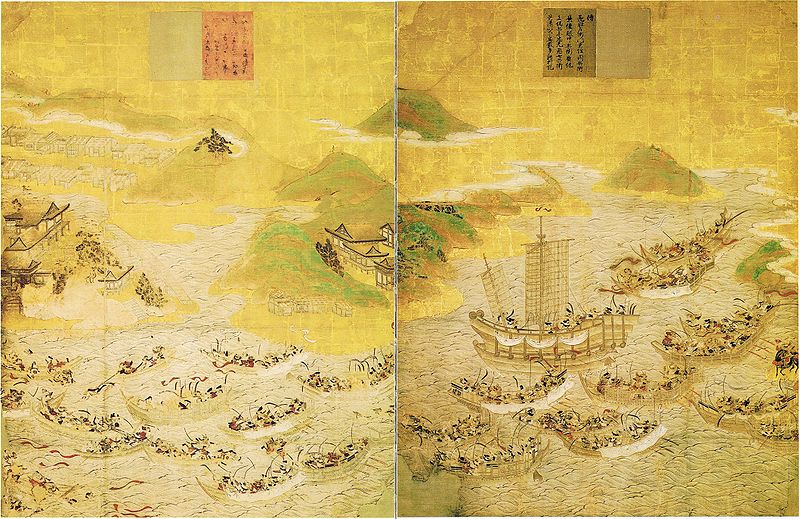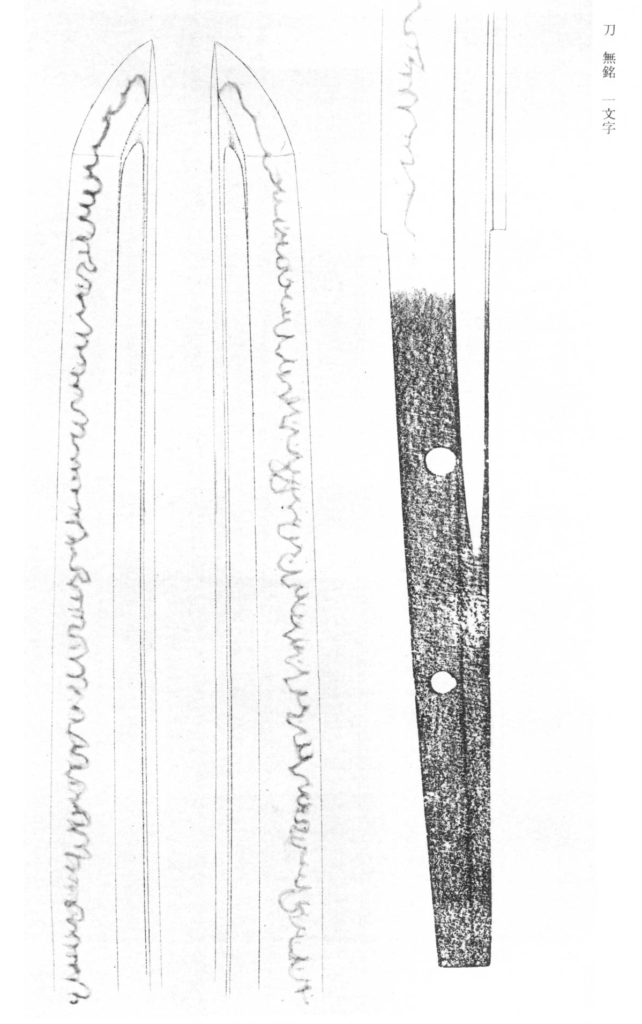Gallery Page (Display Only)
It is a very interesting fact that “Ichimonji”, the most famous school of sword making during the Kamakura period (70% of today’s National Treasure swords are from this period), actually had its grass roots beginnings at sea. Had there never been a battle of “Dan-no-ura” it is almost certain that the Ichimonji school would never have been born. The majority of “Ichimonji” smiths were from Bizen.
“Bizen” is the only province that has experienced continuous sword production from the “Heian” period to the “Shin-Shinto” period. Thus, experienced sword smiths of the high levels were abundant. Throughout the history of sword making, Bizen province was dominate. Bizen province possessed all of the necessary elements and requirements for successful sword making. “Bizen Tetsu” (iron) was exceptional purity and of the highest quality. High grade sand was also available as it was close to the sea. The water supply from the “Asahi Gawa” and “Yoshi Gawa” rivers was very pure. The soil produces fine wood, from which some of the highest grade charcoal ever seen is produced, even to this day. The other significant factor is the supply route; the “Sanyodo Highway” passes directly through Bizen. In summary, the conditions in Bizen were absolutely ideal for sword making. Bizen is credited with the highest sword production statistics in the history of Japan. “Bizen Osafune”, the city of sword smiths. At one time, 80% of the residents of Osafune were sword smiths. With so many sword smiths living in close proximity, the sharing of advancements, thoughts, and technology was responsible for a vast number of improvements and innovations in the art of sword making. This gave the Osafune school a tremendous advantage in an age of less than ideal nationwide communication.
The Yoshioka Ichimonji group worked from 1288 to the mid 1300s with the founder being Sukeyoshi, who was the grandson of Fukuoka Ichimonji Sukemune Kamakura era into Nanbokucho era. They were very active and processed group at Yoshioka, which is located at the West side of the Yoshii river in Bizen province. With Ichimonji groups, they are associated with the names of the land; Fukuoka, Yoshioka, Katayama and Iwado (Oki)

Juyo Zufu translation:
Jūyō-Tōken at the 19th Jūyō Shinsa held on June 1, 1970
Katana, mumei: Ichimonji (一文字)
Hiroshima Prefecture, Nagao Yoshiharu (長尾善治)
Measurements
Nagasa 69.5 cm, sori 2.0 cm, motohaba 2.9 cm, sakihaba 2.0 cm, kissaki-nagasa 2.9 cm, nakago-nagasa 19.8 cm, no nakago-sori
Description
Keijō: shinogi-zukuri, iori-mune, despite the suriage a relatively deep sori, chū-kissaki
Kitae: itame that features ji-nie and a midare-utsuri
Hamon: chōji-midare with a rather tight nioiguchi and mixed with fairly densely arranged gunome elements and with plenty of ashi and yō
Bōshi: a little bit midare-komi with a ko-maru-kaeri
Horimono: on both sides a bōhi that runs as kaki-nagashi into the tang
Nakago: ō-suriage, kirijiri, katte-sagari yasurime, two mekugi-ana, mumei
Explanation
This blade can be identified as a Bizen Ichimonji (一文字) School work from the middle to the late Kamakura period. Although the elements of the ha are fairly densely arranged, the jiba is overall of an excellent deki and is apart from that also perfectly healthy (kenzen).
——————————————————————
1971 was the last year Juyo Token was the highest ranking possible for a sword. The Juyo blades judged 1971 and prior are considered to be more significant because it was then that the NBTHK chose the Juyo Token ranking with the understanding that they were the absolute top ranking.
——————————————————————
CONDITION: Excellent
KIZU (FLAWS): None
POLISH: 100%
DAMAGE: None
HABAKI: Copper with Gold foil & mokume pattern with sukashi design of yanone or a yari flying through the wind.
SHIRA SAYA (STORAGE CASE)
SAYA-GAKI TRANSLATION:
⼀⽂字
但⼤磨上無銘也出来⾒事
⻑貮尺参⼨分有之
昭和戊申年初秋吉⽇
寒⼭誌「花押」
Ichimonji
Tadashi ō-suriage mumei nari, deki migoto
Nagasa ni-shaku san-sun bu kore ari
Shōwa tsuchinoe-sarudoshi shoshū kichijitsu
Kanzan shirusu + kaō
Ichimonji
The blade is ō-suriage mumei; of gorgeous interpretation
Blade length ~ 69.7 cm
Written by Kanzan on a lucky day in early fall [usually the seventh lunar month] of the year of the
monkey of the Shōwa era (1968) + monogram
Blade
"Battle of Dan-no-ura in 1185"

“KYUSHU”, HOMELAND OF THE “GENJI – HEIKE” SEA WAR, AND THE “ICHIMONJI” SCHOOL.
The battle of Dan-no-ura was a major sea battle of the Genpei War, occurring at Dan-no-ura, in the Shimonoseki Strait off the southern tip of Honshū. On March 24, 1185, the Genji (Minamoto) clan fleet, led by Minamoto no Yoshitsune, defeated the Heike (Taira) clan fleet, during a half-day engagement.
The Taira were outnumbered, but some sources say that they had the advantage over the Minamoto in understanding the tides of that particular area, as well as naval combat tactics in general. The Taira split their fleet into three squadrons, while their enemy arrived en masse, their ships abreast, and archers ready. The beginning of the battle consisted mainly of a long-range archery exchange, before the Taira took the initiative, using the tides to help them try to surround the enemy ships. They engaged the Minamoto, and the archery from a distance eventually gave way to hand-to-hand combat with swords and daggers after the crews of the ships boarded each other. However, the tide changed, and the advantage was given back to the Minamoto.
One of the crucial factors that allowed the Minamoto to win the battle was that a Taira general by the name of Taguchi Shigeyoshi defected, and revealed to the Minamoto which ship the six-year-old Emperor Antoku was on. Their archers turned their attention to the helmsmen and rowers of the Emperor’s ship, as well as the rest of their enemy’s fleet, sending their ships out of control. Many of the Taira warriors, including Taira no Tomomori, Taira no Tsunemori and Taira no Norimori, as they saw the battle turn against them, threw themselves overboard, committing suicide rather than having to face defeat at the hands of the Minamoto. Among those who perished this way were Antoku and his grandmother, the widow of Taira no Kiyomori, head of the clan. To this day, the Heike Crabs found in the Straits of Shimonoseki are considered by the Japanese to hold the spirits of the Taira warriors.
The Taira attempted to toss the imperial regalia off the ship but only managed to get the sword and mirror into the water before the ship holding the regalia was captured. The mirror was recovered by divers; many presume the sword to have been lost at this time, though it is officially said to have been recovered and enshrined at Atsuta Shrine.
This decisive defeat of the Taira forces led to the end of the Taira bid for control of Japan. Minamoto Yoritomo, the elder half-brother of Minamoto Yoshitsune, became the first Shogun, establishing his military government (‘bakufu’) in Kamakura. In this battle the Taira lost Taira Tomomori, Taira Noritsune, Taira Norimori, Taira Tsunemori, Taira Sukemori, Taira Arimori and Taira Yukimori were killed.
"The ghost of Taira Tomomori along with the anchor he drowned with, and heikegani with faces of fallen soldiers"

"Samurai Crab" The Heikegani

Heikegani (Heikeopsis japonica) is a species of crab native to Japan, with a shell that bears a pattern resembling a human face which many believed to be the face of an angry samurai hence the nickname Samurai Crab. It is locally believed that these crabs are reincarnations of the spirits of the Heike warriors defeated at the Battle of Dan-no-ura as told in The Tale of the Heike.
This Sword is not available for purchase.
If you wish to purchase a Japanese Sword, please view our Nihonto for sale page or contact us directly via email or by telephone at 1(608) 315-0083 any time. Please include specifics of what you seek, i.e.: Katana, maker, era, price range, etc.
Pictures and content may not be copied without the express permission of samuraisword.com ©












